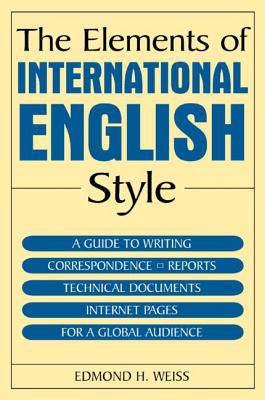
- Afhalen na 1 uur in een winkel met voorraad
- Gratis thuislevering in België vanaf € 30
- Ruim aanbod met 7 miljoen producten
- Afhalen na 1 uur in een winkel met voorraad
- Gratis thuislevering in België vanaf € 30
- Ruim aanbod met 7 miljoen producten
Zoeken
The Elements of International English Style
A Guide to Writing Correspondence, Reports, Technical Documents, and Internet Pages for a Global Audience
Edmond H Weiss
Paperback | Engels
€ 59,45
+ 118 punten
Uitvoering
Omschrijving
This easy-to-use handbook is an essential resource for anyone who needs to write English correspondence for an international business audience. In an engaging, accessible style it integrates the theory and controversies of intercultural communication with the practical skills of writing and editing English for those who read it as a second language. The book emphasizes principles of simplicity and clarity, proper etiquette, cultural sensitivity, appropriate layout and typography, and more to increase the chances that a text prepared by a native English speaker will be better understood by a non-native speaker. It also updates traditional advice with new insights into "e-mail culture." Equally useful for students and professionals in business communication, marketing communication, and international business, The Elements of International English Style is filled with realistic examples, problems, and projects, including: 57 specific tactics to internationalize one's English; hundreds of before-and-after comparisons showing the effects of editing for an international audience; models of international correspondence; practical discussion questions and work projects; useful resources for further study, including books, articles, and websites.
Specificaties
Betrokkenen
- Auteur(s):
- Uitgeverij:
Inhoud
- Aantal bladzijden:
- 192
- Taal:
- Engels
Eigenschappen
- Productcode (EAN):
- 9780765615725
- Verschijningsdatum:
- 31/03/2005
- Uitvoering:
- Paperback
- Formaat:
- Trade paperback (VS)
- Afmetingen:
- 154 mm x 229 mm
- Gewicht:
- 272 g

Alleen bij Standaard Boekhandel
+ 118 punten op je klantenkaart van Standaard Boekhandel
Beoordelingen
We publiceren alleen reviews die voldoen aan de voorwaarden voor reviews. Bekijk onze voorwaarden voor reviews.











